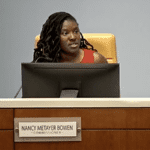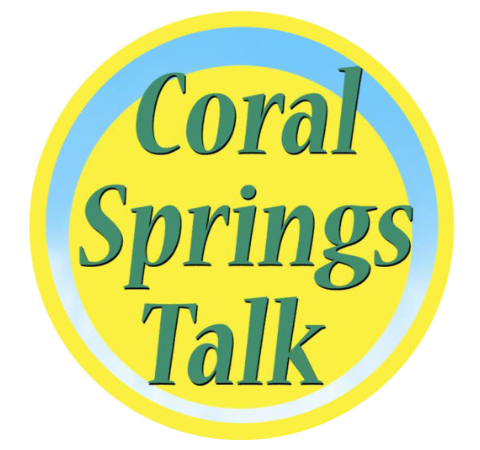
Coral Glades High School in Coral Springs.
By Bryan Boggiano
This story has been updated to provide additional context and clarification to the H1 reboundary plan. The incoming “freshmen” was replaced with incoming “students.”
After months of hearings and contentious arguments surrounding MSD rezoning, the school board voted 6-3 in favor of the H1 boundary proposal, rezoning 351 incoming Coral Springs students from Marjory Stoneman Douglas High School to Coral Glades High School over a four-year period.
The change will be effective starting in the 2023/2024 school year. Current MSD students will not be affected.
The school board made the MSD rezoning decision at their second school boundary public hearing Wednesday at J.P. Taravella High School to alleviate overcrowding at the Parkland high school.
Coral Springs residents and officials, on the other hand, argued that H1 affected only Coral Springs residents and did not look at rezoning from a strategic, countywide perspective, also arguing the MSD rezoning process was flawed.
Wednesday’s public hearing followed the first boundary hearing on March 29, where school board officials voted 6-2 in favor of the H1 proposal, sending it off to Wednesday’s final vote.
Immediately prior to the March 29 meeting, the school board sent out an email and text update stating the vote on H1 would be removed and replaced by Interim Superintendent Dr. Earlean Smiley’s recommendation to keep all boundaries the same, citing violations of Policy 5000.
Despite that, the board ultimately moved to approve the H1 proposal. In response, multiple Coral Springs residents stated they felt they were misled at a special city commission meeting on April 4. At this meeting, commissioners also explored revisiting contracts with Parkland, including fire and paramedic services, and filing an injunction to stop the MSD rezoning process.
In response, Parkland residents aired their concerns to the commission at that city’s April 6 meeting.
Those polarizing responses continued into Wednesday’s meeting.
Karina Melendez, a Coral Springs parent, said, “If H1 passes, this will not be the last you hear of me because we purchased our home specifically for Douglas.”
James Cardiello argued the MSD rezoning would have a disproportionate effect on Black and Hispanic students, saying, “this looks and sounds like what it is: another form of gentrification.”
MSD students and Parkland residents largely focused on overcrowding and safety issues.
“Even getting into the school is an issue,” said Alexander Briggs.
Similarly, Jessica Bailey said, “downsizing is the only effective solution to an overcrowded school.”
Elected officials in both Coral Springs and Parkland also displayed vastly differing opinions of the MSD rezoning proposal.
Coral Springs Commissioner Joshua Simmons labeled the boundary effort as a “stopgap” for just the upcoming year, arguing the rezoning process should have been done on a countywide basis.
Similarly, Commissioner Nancy Metayer Bowen said, “This process has not been equitable, as only one community has been impacted.”
Commissioner Joy Carter and Mayor Scott Brook argued to put off rezoning for one more year, stating a delay would help heal the divisions between both cities.
Members of the Parkland Commission argued that MSD overcrowding has to be addressed immediately, with Vice Mayor Simeon Brier saying the overcrowding at MSD “has reached a critical level.”
Commissioner Ken Cutler echoed Brier’s messaging, saying, “[the decision] has been kicked down the road long enough.”
While Mayor Rich Walker and Commissioner Bob Mayersohn argued for addressing enrollment gaps and ensuring students and staff get the highest level of service possible at all schools, respectively, Commissioner Jordan Isrow criticized those opposed to H1 for not participating in helping throughout the MSD rezoning process.
He stated those opposed to H1 were “dissenting based on threats,” including lawsuits and removing fire services from the city.
“Imagine that, trying to solve a safety issue by doubling down,” he said.
In her statements, Vice Chair Debra Hixon said that as someone who lost her husband, Chris Hixon, at MSD, she thinks linking safety and MSD would elicit a different response from any other schools in the district.
“I think it’s disingenuous to come up and say that MSD is not safe,” she said.
Chair Lori Alhadeff stated the process was thoroughly vetted and argued the need for addressing safety and operational-related concerns that would come with additional students. She referred to Smiley for eighth-grade transition-related concerns, including adequate course selection options and district meetings with each household to hear their concerns.
Alhadeff also discussed providing additional academic coaches to J.P. Taravella, Coral Springs, and Coral Glades high schools, in addition to other schools with grades below a B.
“It is very important that we take action today, and we don’t kick the can down the road,” she said.
School Board Member Tory Alston moved to approve the H1 rezoning proposal, which Member Daniel Foganholi seconded.
The H1 boundary proposal passed 6-3. Alhadeff, Alston, Foganholi, and School Board Members Allen Zeman, Brenda Fam, and Nora Rupert supported it. Hixon, and School Board Members Sarah Leonardi and Dr. Jeff Holness opposed it.
In a text message afterward, Simmons said, “It’s unfortunate that the school board moved forward with removing 351 Coral Springs children from the MSD zone over the next four years. They also stripped numerous families’ rights to send their kids to MSD. It was a slanted process from the very beginning, but I am proud of how hard Coral Springs residents fought for their children and their future.”
Send Your News to Coral Springs #1 Award-Winning News Site Here. Don’t miss reading Parkland Talk, Tamarac Talk, Coconut Creek Talk, and Margate Talk.
Author Profile

Related
 NewsJanuary 1, 2024BEST OF 2023: Inspiring Fitness Journey Earns Resident National Recognition
NewsJanuary 1, 2024BEST OF 2023: Inspiring Fitness Journey Earns Resident National Recognition NewsNovember 20, 2023Charter School Alum Works Toward Equity For Black Veterans
NewsNovember 20, 2023Charter School Alum Works Toward Equity For Black Veterans NewsNovember 16, 2023Coral Springs Joins Regional Climate Effort, Commits to Bold Action Plan for Environmental Resilience
NewsNovember 16, 2023Coral Springs Joins Regional Climate Effort, Commits to Bold Action Plan for Environmental Resilience NewsNovember 8, 2023Meet Dr. Juliana Forero: Leading Coral Springs Museum to New Heights with Inclusivity
NewsNovember 8, 2023Meet Dr. Juliana Forero: Leading Coral Springs Museum to New Heights with Inclusivity







